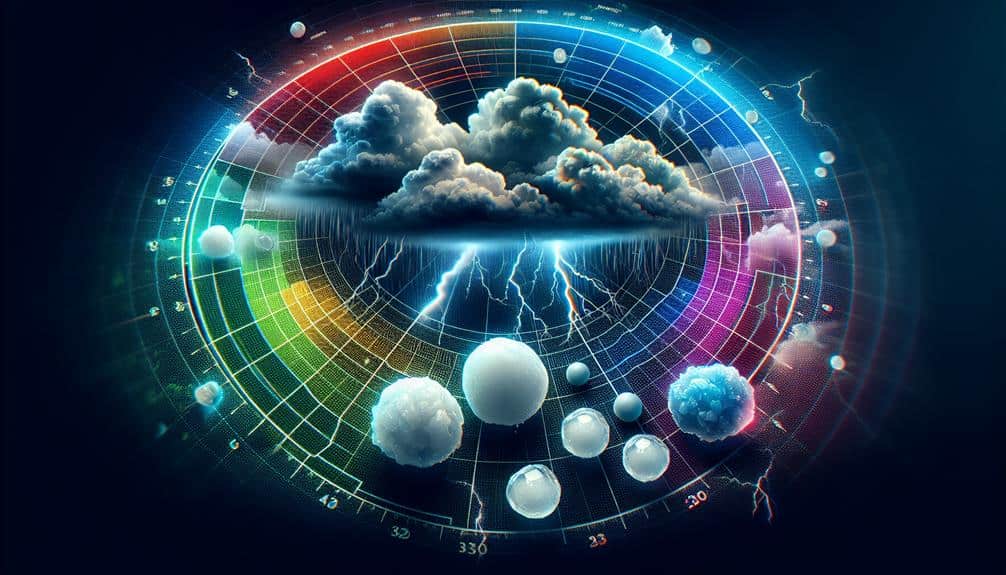We utilize Doppler radar to predict hailstorms through targeted analyses such as echo patterns, identifying velocity signatures, and examining reflectivity levels. By leveraging dual-polarization technology, we differentiate precipitation types and detect hailstone size. Tracking storm motion and evaluating updraft strength enhance our forecasts. Integrating real-time data and using extensive radar networks ensures no storm goes unnoticed. Algorithms process these data points to model hailstorm paths and issue accurate warnings. With such advanced approaches, we've increased our hailstorm prediction accuracy and timeliness. For a detailed look at each method and our technological advancements, continue exploring.
Key Points
- Echo Patterns Analysis: Identifies potential hail cores within storm cells by examining intensity and structure of radar returns.
- Velocity Signatures Identification: Detects rotational patterns and wind shear, enhancing hailstorm prediction accuracy.
- Reflectivity Levels Examination: Differentiates between rain and hail by analyzing high reflectivity indicators on Doppler radar.
- Dual-Polarization Technology: Enhances differentiation between precipitation types and reliably identifies hailstones.
Analyzing Echo Patterns
When analyzing echo patterns, we focus on the intensity and structure of the radar returns to identify potential hail cores within storm cells. By examining the reflectivity values, we can determine the density and size of the precipitation particles. Higher reflectivity often indicates larger hailstones, which correspond to more severe weather conditions. We pay special attention to the vertical and horizontal structures of the storm.
Echo analysis allows us to dissect the storm structure by looking at cross-sections of radar returns at different altitudes. This helps us pinpoint the specific layers where hail formation is most likely occurring. If we observe a high reflectivity core suspended above the ground, it may indicate a strong updraft, which is essential for hailstone development.
Moreover, by integrating data from multiple radar sources, we can construct a three-dimensional model of the storm. This model enables us to track the evolution of hail cores over time, providing critical insights into storm dynamics. Accurate echo analysis empowers us to make more informed predictions, helping us anticipate severe weather and ultimately giving us the freedom to prepare and respond effectively.
Identifying Velocity Signatures
In addition to analyzing echo patterns, we leverage Doppler radar to identify velocity signatures that reveal the movement and intensity of storm winds, critical for determining hailstorm potential.
By examining the radial velocity data, we can detect rotational patterns and wind shear that often precede severe hail. These velocity signatures provide key indicators of storm dynamics, enabling us to forecast hailstorms with greater precision.
Despite significant advancements in Doppler radar technology, we must acknowledge its limitations. For instance, the radar's effectiveness diminishes with distance, reducing the accuracy of velocity data for remote storms. Additionally, radar can't always distinguish between different precipitation types, which can affect hailstorm forecasting.
However, recent Doppler radar advancements have markedly improved hailstorm prediction accuracy. Enhanced resolution and dual-polarization capabilities allow us to better discern the size and density of hailstones within a storm.
This data-driven approach empowers us to make more accurate predictions, ultimately offering more freedom to those in the storm's path by providing timely and reliable warnings.
Identifying velocity signatures is a pivotal step in our analytical process, bridging the gap between raw radar data and actionable forecasts that safeguard lives and property.
Examining Reflectivity Levels
When we examine reflectivity levels, we focus on high reflectivity indicators that suggest the presence of hail.
By analyzing reflectivity patterns, we can differentiate between rain and hail, since hailstones produce stronger radar echoes.
This data-driven approach allows us to predict hail storms with greater accuracy and timeliness.
High Reflectivity Indicators
To predict hail storms effectively, we analyze high reflectivity levels on Doppler radar, as these indicators often signify the presence of large ice particles within storm clouds. When Doppler technology detects high reflectivity values, typically above 55 dBZ, it suggests significant hail formation. These readings correlate with storm severity, allowing us to anticipate potential damage.
High reflectivity indicates that the radar waves are bouncing off large, dense objects—precisely the kind of signal produced by hailstones. By examining these elevated reflectivity levels, we can pinpoint areas where hail is likely forming. This capability is essential for hail detection and timely warnings, providing a measure of freedom from unexpected damage for communities in the storm's path.
The data-driven approach of Doppler radar enhances our understanding by offering real-time insights. Reflectivity levels enable us to dissect the storm structure vertically, discerning the altitude and size distribution of hailstones. This analytical reasoning helps us not only in predicting hail but also in estimating its potential impact, thereby contributing to more effective storm preparedness and response strategies.
Through precise examination of high reflectivity indicators, we guarantee accurate and actionable weather forecasting.
Reflectivity Patterns Analysis
Analyzing reflectivity patterns involves scrutinizing the radar's detailed data to identify specific structures and intensities within the storm, enabling precise localization and characterization of hail-producing regions. Reflectivity interpretation is paramount in hailstorm formation analysis as it provides us with critical insights into the storm's internal dynamics.
By examining high reflectivity levels, typically over 55 dBZ, we can pinpoint areas where hail is likely forming.
Our storm tracking efforts rely heavily on understanding these reflectivity patterns. For instance, a bounded weak echo region (BWER) is an indicator of strong updrafts, often associated with severe hail. When we detect such patterns, we can anticipate hail detection with higher confidence.
Additionally, the presence of a three-body scatter spike (TBSS) is a strong indication that large hail is present, as the radar signals scatter off the hailstones and create a distinct signature.
Reflectivity data also helps us gauge the potential size of the hail. Larger hailstones reflect more radar energy, resulting in higher reflectivity values. By continuously monitoring these patterns, we can provide more accurate and timely warnings, helping people exercise their freedom to take precautionary measures and stay safe.
Dual-Polarization Technology
Dual-polarization technology significantly enhances Doppler radar's capacity to differentiate between hail and other types of precipitation by analyzing the shape and orientation of hydrometeors. This advanced technique transmits and receives polarized radio wave pulses in both horizontal and vertical orientations. By comparing these dual-polarized signals, we can extract detailed information about the particles suspended in the atmosphere.
Concerning weather modeling, dual-polarization allows us to more accurately characterize the size, shape, and phase of hydrometeors. This precision enables better assimilation of observational data into numerical models, resulting in improved storm forecasting. Specifically, we can identify hailstones more reliably by detecting their unique signatures—typically larger and more spherical compared to other precipitation types. This distinction is essential for producing accurate weather warnings and minimizing false alarms.
Moreover, the data acquired through dual-polarization can be used to estimate the likelihood of hail formation within a storm system. By integrating this data into existing weather models, we enhance our predictive capabilities, giving communities more lead time to prepare and mitigate damage.
Essentially, dual-polarization technology is a significant step forward in our pursuit of meteorological freedom, providing us with the tools to predict severe weather with greater accuracy and confidence.
Tracking Storm Motion
By leveraging real-time data from Doppler radar systems, we can accurately track storm motion and predict the trajectory of hail-producing thunderstorms. This ability hinges on several vital factors that Doppler radar helps us monitor, ensuring we're well-informed and prepared.
- Storm Formation: Observing the initial stages of storm formation allows us to anticipate the development of severe weather. Doppler radar captures data on wind patterns and moisture levels, providing insights into the conditions that could potentially lead to hailstorms.
- Precipitation Intensity: By measuring the intensity of precipitation, we can identify areas of heavy rainfall that typically accompany hail. The radar system quantifies the reflectivity of precipitation particles, giving us a clear picture of where the most intense storms are located.
- Velocity Data: Doppler radar measures the velocity of precipitation particles, enabling us to determine the speed and direction of storm movement. This data is essential for tracking the path of the storm and predicting its future position.
- Storm Structure: Analyzing the vertical structure of the storm helps us understand its potential severity. By examining the echo tops and the distribution of precipitation within the storm, we can infer the likelihood of hail formation.
These elements, when combined, empower us to make accurate predictions, ensuring we remain in control and ready for any weather challenges.
Detecting Updraft Strength
Detecting updraft strength is vital for predicting hail storms, as it allows us to assess the storm's potential to lift water droplets high enough to freeze into hailstones. Utilizing Doppler radar, we conduct updraft analysis by measuring wind velocities within the storm. Strong updrafts, often exceeding 15 meters per second, indicate the presence of severe weather conditions conducive to hail formation.
Through meticulous storm prediction, we identify areas where updrafts are most intense. Doppler radar's ability to differentiate between horizontal and vertical wind components provides a dynamic view of storm structures. This data-driven approach enables us to pinpoint regions of rapid vertical air movement, critical for understanding the storm's development.
We monitor reflectivity and velocity data to ascertain the updraft's power. High reflectivity values, combined with strong vertical velocities, signal the likelihood of hail formation. By analyzing these parameters, we can predict the potential intensity of the storm and its capacity to produce hail.
In our pursuit of freedom from unwelcome surprises, understanding updraft strength through precise, analytical reasoning is crucial. This allows us to issue timely warnings and mitigate the impact of severe weather, ultimately safeguarding communities from hail storms.
Assessing Hail Size Potential

To assess hail size potential, we'll analyze radar reflectivity and VIL. High reflectivity values often indicate larger hailstones, while VIL provides a quantitative measure of the liquid water content in a storm.
Reflectivity and Hail Detection
Reflectivity measurements on Doppler radar provide crucial data for analyzing the size potential of hail within a storm system. By examining the echoes produced by precipitation particles, we can deduce key aspects of hailstone formation and storm intensity. Higher reflectivity values often indicate larger hailstones and more intense storms, which are essential for effective storm tracking and public safety.
When evaluating hail size potential, we focus on several parameters:
- Reflectivity Values: High reflectivity values (dBZ) often correspond to larger hailstones. Values exceeding 55 dBZ typically suggest severe hail.
- Echo Tops: The height of the radar echo tops can indicate the storm's strength. Higher tops generally correlate with stronger updrafts, which contribute to larger hailstone formation.
- Differential Reflectivity (ZDR): This helps differentiate between rain and hail. Low or negative ZDR values often signal the presence of hail within the precipitation column.
- Hydrometeor Classification: Algorithms classify precipitation types, aiding in identifying hail within the storm.
VIL (Vertical Integrated Liquid) Analysis
Building on the insights from reflectivity measurements, we can enhance our hail size predictions by analyzing VIL (Vertical Integrated Liquid) values, which offer a thorough view of the liquid content within a storm's vertical column.
By examining VIL values, we gain a clearer picture of the total amount of liquid water present, which directly correlates with hail formation and growth.
Higher VIL values typically indicate more significant liquid content, suggesting an elevated potential for larger hailstones. When we combine VIL data with reflectivity information, we can more accurately assess both rainfall intensity and storm severity. This inclusive approach allows us to pinpoint areas within a storm that are most likely to produce significant hail, thereby refining our prediction models.
Moreover, VIL analysis helps us distinguish between ordinary rainfall and severe weather events. For instance, VIL values exceeding 50 kg/m² often correlate with severe thunderstorms capable of producing damaging hail.
By integrating this data into our radar systems, we can issue more timely and precise warnings, empowering individuals to take necessary precautions and preserving their sense of freedom.
In essence, VIL analysis is an essential tool that enhances our ability to predict hail size and storm severity with greater accuracy and confidence.
Utilizing Doppler Radar Networks
Doppler radar networks enable meteorologists to analyze real-time atmospheric data across vast regions, allowing for early detection and prediction of hail storms. By leveraging radar network coverage, we can monitor storm systems as they develop and track their movements with precision. This extensive coverage is essential for accurate storm prediction, especially when dealing with severe weather events like hail storms.
Doppler technology enhances our ability to detect severe weather by measuring the velocity of precipitation particles. This data lets us identify rotation within storm cells, a key indicator of potential hail formation.
Here's how we utilize these networks:
- Wide-Area Monitoring: By integrating multiple radar stations, we achieve widespread radar network coverage, ensuring no storm goes unnoticed.
- Velocity Analysis: Doppler radar captures the motion of precipitation, helping us pinpoint areas of strong winds and potential hail.
- Reflectivity Data: High reflectivity on radar images signals dense precipitation, often associated with hail cores.
- Storm Tracking: Continuous data updates allow us to follow the storm's path, providing timely warnings to affected areas.
For those who value freedom, precise hail storm prediction means better preparation and the freedom to make informed decisions. By understanding and utilizing Doppler radar networks, we're empowering ourselves with the tools to stay safe and proactive.
Real-Time Data Integration

To improve our storm prediction capabilities, we integrate real-time data from Doppler radar networks with advanced computational models, enabling precise analysis and timely updates. By leveraging radar technology, we continuously monitor atmospheric conditions, collecting high-resolution data on precipitation, wind patterns, and storm cell dynamics. This real-time integration guarantees that our weather monitoring systems adapt swiftly to evolving storm conditions.
We employ sophisticated data visualization techniques to interpret the vast amount of information gathered. These visualizations allow us to identify key indicators of hailstorm formation, such as updraft intensity and echo tops. By analyzing these visual cues, we enhance our storm prediction accuracy, giving us a clearer picture of imminent severe weather.
Our advanced algorithms process the radar data in milliseconds, providing instantaneous feedback that's essential for timely decision-making. This rapid processing capability is a game-changer in weather monitoring, enabling us to issue warnings well in advance of hailstorm impacts.
The integration of real-time data and computational models not only improves our predictive accuracy but also empowers individuals and communities with the freedom to prepare and act swiftly, mitigating potential damage and ensuring safety.
Predicting Hailstorm Path
By leveraging high-resolution data from Doppler radar, we can accurately map and predict the path of hailstorms with remarkable precision. This capability hinges on our understanding of hailstorm formation and the atmospheric conditions that drive these severe weather events. We use Doppler radar to analyze the wind patterns, moisture content, and temperature fluctuations that precede a hailstorm.
This high-resolution data enables us to pinpoint the storm's exact location, its trajectory, and potential areas of impact.
To enhance our predictive capabilities, we follow a systematic approach:
- Data Collection: We gather extensive data on atmospheric conditions, including wind shear, humidity, and temperature gradients.
- Modeling: Advanced algorithms process this data to simulate the hailstorm's development and movement.
- Path Projection: Using real-time updates, we refine the storm's predicted path, adjusting for changes in speed and direction.
- Severity Assessment: By evaluating the hailstorm severity, we can anticipate potential damage and issue timely warnings.
Our analytical reasoning is grounded in data-driven methods, ensuring that our predictions aren't just accurate but also actionable. This empowers individuals and communities to make informed decisions, minimizing the damage assessment and impact of severe hailstorms.
Frequently Asked Questions
How Does Doppler Radar Differ From Traditional Weather Radar?
When we look at Doppler radar technology, it's like peeling back layers of a storm's secrets. Unlike traditional weather radar, Doppler captures velocity data, revealing intricate weather patterns and giving us more precise storm predictions.
What Is the History of Doppler Radar Development?
The history of Doppler radar development shows significant advancements since its inception in the 1940s. We've seen technological leaps that have vastly improved accuracy and storm prediction, empowering us with greater freedom to prepare and respond.
Can Doppler Radar Predict the Exact Time a Hailstorm Will Hit?
Like a vigilant watchdog, Doppler radar can't predict the exact time a hailstorm will hit. However, it provides critical data on hailstorm impact, allowing us to take safety precautions and manage hailstorm damage with proper insurance coverage.
Are There Any Limitations to Using Doppler Radar for Weather Prediction?
We face accuracy limitations and data interpretation limitations when using Doppler radar for weather prediction. While it's powerful, the radar's precision can be affected by factors like terrain, technology constraints, and the complexity of atmospheric conditions.
How Do Meteorologists Train to Interpret Doppler Radar Data?
Meteorologists spend up to 200 hours annually in training to master radar interpretation. We analyze velocity data, reflectivity patterns, and storm structures. This rigorous training guarantees we provide accurate forecasts, empowering communities to make informed safety decisions.


